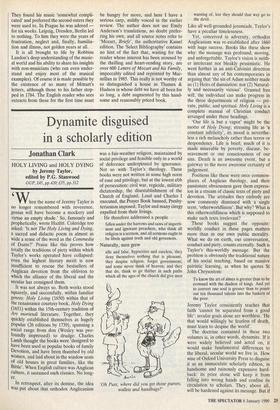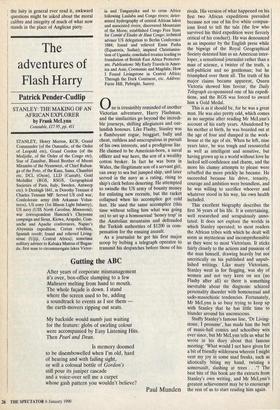Dynamite disguised in a scholarly edition
Jonathan Clark
HOLY LIVING and HOLY DYING by Jeremy Taylor, edited by P.G. Stanwood OUP, £45, pp.420; £35, pp.312 hen the name of Jeremy Taylor is no longer remembered with reverence, genius will have become a mockery and virtue an empty shade.' So, famously and prophetically, wrote Hazlitt. Coleridge too asked: 'Is not The Holy Living and Dying, a sacred and didactic poem in almost as wide a sense of the word as the Commedia of Dante?' Praise like this proves how totally the traditions of piety within which Taylor's works operated have collapsed: even the highest literary merit is now insufficient to rescue the bestsellers of Anglican devotion from the oblivion to which the alliance of the liberal and the secular has consigned them.
It was not always so. Both works stood squarely, and successfully, within familiar genres: Holy Living (1650) within that of the renaissance courtesy book, Holy Dying (1651) within the 15th-century tradition of Ars moriendi literature. Together, they quickly established themselves as hugely popular (26 editions by 1739), spanning a social range from don (Wesley was pro- foundly impressed) to drudge: Charles Lamb thought the books were 'designed to have been used as popular books of family Devotion, and have been thumbed by old women, and laid about in the window seats of old houses in great families, like the Bible'. When English culture was Anglican culture, it sustained such classics. No long- er.
In retrospect, after its demise, the idea was put about that orthodox Anglicanism was a fair-weather religion, maintained by social privilege and feasible only in a world of deference underpinned by ignorance. Not so with Taylor's theology. These books were not written in some high noon of ease and privilege, but at the lowest ebb of persecution: civil war, regicide, military dictatorship, the disestablishment of the Church of England, Laud and Charles I executed, the Prayer Book banned, Presby- terianism imposed, Taylor and many clergy expelled from their livings.
He therefore addressed a people
fallen under the harrows and saws of imperti- nent and ignorant preachers, who think all religion is a sermon, and all sermons ought to be libels against truth and old governors.
Naturally, men grew
idle and false, hypocrites and careless, they deny themselves nothing that is pleasant, they despise religion, forget government; and some never think of heaven; and they that do, think to go thither in such paths which all the ages of the church did give men
'Oh Puss, where did you get those purses, wallets and handbags?'
warning of, lest they should that way go to the devil.
Like all well-grounded jeremiads, Taylor's have a peculiar timelessness.
Yet, conceived in adversity, orthodox Anglicanism was re-established after 1660 with huge success. Books like these show why: the message was profound, moving, and unforgettable. Taylor's vision is neith- er intolerant nor bleakly pessimistic. He went further in an anti-Calvinist direction than almost any of his contemporaries in arguing that 'the sin of Adam neither made us (1) Heirs of damnation: nor (2) Natural- ly and necessarily vicious'. Granted free will, the individual can make progress in the three departments of religion — pri- vate, public, and spiritual. Holy Living is a complete manual of Christian conduct arranged under these headings.
'Our life is but a vapor' might be the motto of Holy Dying; stressing life as 'a constant infelicity', its mood is neverthe- less a rich melancholy rather than terror or despondency. Life is brief; much of it is made miserable by poverty, disease, be- reavement or our consciousness of our sins. Death is an awesome event, but a gateway to the more awesome certainty of judgement.
Positions like these were once common- places of Anglican theology, and their passionate obviousness gave them express- ion in a stream of classic texts of piety and devotion. The attitudes they embody are now commonly dismissed with a single term, 'otherworldliness'. But why? What is this otherworldliness which is supposed to make such texts irrelevant?
These books suggest the opposite: worldly conduct in these pages matters more than in our own public morality. What we do on earth, our conversation, conduct and piety, counts eternally. Such is Taylor's this-worldly message. But the problem is obviously the traditional nature of his social teaching, based on massive patristic learning, as when he quotes St John Chrysostom:
To know the art of almes is greater than to be crowned with the diadem of kings. And yet to convert one soul is greater than to poure out ten thousand talents into the baskets of the poor.
Jeremy Taylor consistently teaches that faith 'cannot be separated from a good life': secular goals alone are worthless. 'He that would willingly be fearless of death, must learn to despise the world'.
The doctrine contained in these two volumes is, in other words, dynamite. If it were widely believed and acted on, it would make fundamental differences to the liberal, secular world we live in. How wise of Oxford University Press to disguise it as an immaculate scholarly edition, in handsome and ruinously expensive hard- back: its price alone will keep it from falling into wrong hands and confine its circulation to scholars. They, above all, will be hardened against its message. But if the laity in general ever read it, awkward ' questions might be asked about the moral calibre and integrity of much of what now stands in the place of Anglican piety.











































 Previous page
Previous page